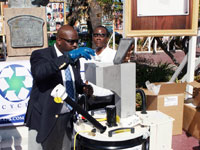 The Ministry of the Environment and Housing demonstrated the final stage of the disposal process of mercury-contained Compact Fluorescent Lightbulbs (CFLs) in Rawson Square November 15.
The Ministry of the Environment and Housing demonstrated the final stage of the disposal process of mercury-contained Compact Fluorescent Lightbulbs (CFLs) in Rawson Square November 15.
The use of CFLs are considered hazardous to the environment and human health, and consequently governments around the world have launched efforts to seek ways to dispose of the bulbs properly.
Minister of the Environment and Housing Kendred Dorsett said a programme has been advanced to bring about a greater degree of energy efficiency with the use of energy efficient appliances and CFLs. He said, however, that because the CFLs contain mercury there must be care and respect in disposing of them as some are ending up in the landfill on Tonique Darling Williams Highway.
Under an Inter-American Development Bank (IDB) pilot project, the Ministry began to collect and replace incandescent bulbs in each home and replace them with Government issued CFLs. The project now includes the demolition of the CFLs and has engaged with a company called Vortex, to supply the technology that collects the mercury and separates it from the casing, and dissolve it in charcoal to neutralise the poison.
“As a part of the IDB programme, which provided us with CFL bulbs, we embarked on getting a bulb eating machine, which is what it is affectionately referred to as, to ensure that systematically we could advance a national programme where depots would be established throughout our islands, where residents can drop off their CFL bulbs to ensure that we can collect them and dispose of them properly to avoid them going into the landfill and therefore possibly causing contamination and issues for us, medium term to long term,” said the Minister.
Minister Dorsett said mercury is not a substance to be played with or ignored and that the Government is monitoring how it enters the landfill. He said they are also monitoring how its presence is being controlled from escalating into hazardous quantities that can cause health concerns.
“This particular machine came in at a cost of $9,000. And so, we are also looking at policies to enable us to reduce that cost to ensure that we are going to be able to aggressively address the proper disposal of CFLs,” he told the media..
“My team has begun some work in terms of discussions with franchise operators as to how they can be incorporated into this programme. I think over the next few weeks you will see some announcements with respect to where those disposal site will be located so that in the new year we can advance this programme.”
The IDB funded the availability of the CFL bulbs, which was distributed to the public last year. This is now the tail end of the programme for which the government wanted to make certain there was a means to retrieve the CFLs and disposed of them properly. The bulb eater was funded by the Ministry of the Environment.
“The team that is responsible for managing this project is to provide us with a report, indicating how their electricity bills have been reduced or impacted by the introduction of the CFL bulbs. And so, that’s one of the reasons why while we have distributed CFL bulbs; I don’t believe there has been as much focus as it ought to be on the assessment and the evaluation of the impact, so that we can have the empirical data that gives us the ability as a government to determine how we will proceed,” said Minister Dorsett.
By Gena Gibbs
Bahamas Information Services
